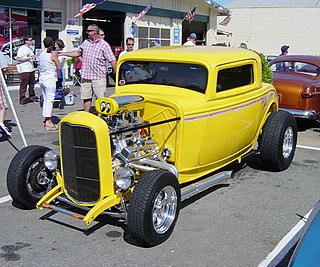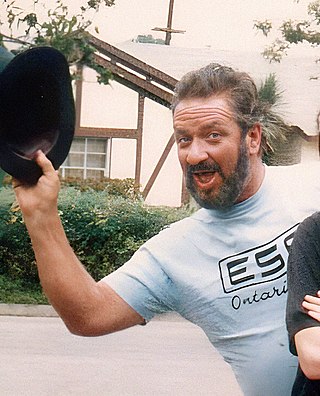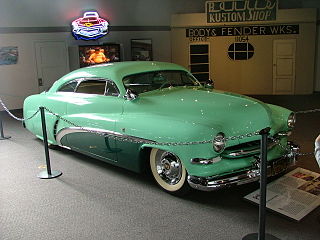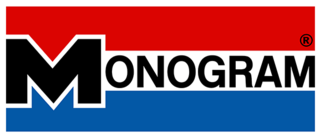
The Ford Galaxie is a full-sized car that was built in the United States by Ford for model years 1959 through 1974. The name was used for the top models in Ford's full-size range from 1958 until 1961, in a marketing attempt to appeal to the excitement surrounding the Space Race. In 1958, a concept car was introduced called "la Galaxie" which incorporated the headlights into pods inline with the grille and a reduced front profile.

The term 1932 Ford may refer to three models of automobile produced by Ford Motors between 1932 and 1934: the Model B, the Model 18, and the Model 40. These succeeded the Model A. The Model B had an updated four-cylinder engine and was available from 1932 to 1934. The V8 was available in the Model 18 in 1932, and in the Model 40 in 1933 & 1934. The 18 was the first Ford fitted with the flathead V-8. The company also replaced the Model AA truck with the Model BB, available with either the four- or eight-cylinder engine.

The Ford Popular, often called the Ford Pop, is a car from Ford UK that was built in England between 1953 and 1962. When launched, it was Britain's lowest priced car.

Hot rods are typically American cars that might be old, classic, or modern and that have been rebuilt or modified with large engines optimized for speed and acceleration. One definition is: "a car that's been stripped down, souped up and made to go much faster." However, there is no definition of the term that is universally accepted and the term is attached to a wide range of vehicles. Most often they are individually designed and constructed using components from many makes of old or new cars, and are most prevalent in the United States and Canada. Many are intended for exhibition rather than for racing or everyday driving.

George Barris was an American designer and builder of Hollywood custom cars. Barris designed and built the Hirohata Merc. Barris's company, Barris Kustom Industries, designed and built the Munster Koach and DRAG-U-LA for The Munsters; and the 1966 Batmobile for the Batman TV series and film.

Edward "Big Daddy" Roth was an American artist, cartoonist, illustrator, pinstriper and custom car designer and builder who created the hot rod icon Rat Fink and other characters. Roth was a key figure in Southern California's Kustom Kulture and hot rod movement of the late 1950s and 1960s.

Michael Lee "Mickey" Thompson was an American auto racing builder and promoter.

A rat rod, as usually known today, is a custom car with a deliberately worn-down, unfinished appearance, typically lacking paint, showing rust, and made from cheap or cast-off parts. These parts can include non-automotive items that have been repurposed, such as a rifle used as a gear shifter, wrenches as door handles, or hand saws as sun visors. Whether or not so appointed, the rat rod uniquely conveys its builder’s imagination.

A custom car is a passenger vehicle that has been either substantially altered to improve its performance, often by altering or replacing the engine and transmission; made into a personal "styling" statement, using paintwork and aftermarket accessories to make the car look unlike any car as delivered from the factory; or some combination of both. A desire among some automotive enthusiasts in the United States is to push "styling and performance a step beyond the showroom floor - to truly craft an automobile of one's own." A custom car in British according to Collins English Dictionary is built to the buyer's own specifications.

Monogram is an American brand and former manufacturing company of scale plastic models of cars, aircraft, spacecraft, ships, and military vehicles since the early 1950s. The company was formed by two former employees of Comet Kits, Jack Besser and Bob Reder.

The Detroit Autorama, also known as America's Greatest Hot Rod Show, is a showcase of custom cars and hot rods held each year at Huntington Place in Detroit, Michigan, in either late February or early March.
Edward Dean Jeffries was an American custom car designer and fabricator, as well as stuntman and stunt coordinator for motion pictures and television programs based in Los Angeles, California.
Dick Dean, born Richard Dean Sawitskas [Sa-WITS-kas], was an American automobile designer and builder of custom cars. Father of Keith Dean.

The Hirohata Merc is a 1950s lead sled custom car, often called "the most famous custom of the classic era". Setting a style and an attitude, it had a "momentous effect" on custom car builders, appeared in several magazines at the time and has reappeared numerous times since, earning an honorable mention on Rod & Custom's "Twenty Best of All Time" list in 1991. The impact may be measured by the fact that, after more than fifty years and numerous owners, it is still known as "the Hirohata Merc".
The Ford Mustang II is a small, front-engined (V8), open "two-plus-two" concept car built by the Ford Motor Company in 1963. Although bearing the same name as the first generation production Mustang, the four-seater Mustang II which closely resembled the final production variant that would appear in 1964, was intended primarily for the auto show circuit. After debuting at the 1963 Watkins Glen Grand Prix, the Mustang II had a short lifespan as a show car before being relegated to the task of "test mule". The sole example still exists, albeit in storage at the Detroit Historical Museum.
Bill Cushenbery was an American car customizer, show car builder, and model kit designer. Cushenbery was a major influence on the look of custom cars and the customizing industry in general. In addition to building his own designs, he is noted for having helped George Barris create the Batmobile car featured in the 1966–1968 Batman television series.
Exodus is a customized 1959 Chevrolet Impala built by Bill Cushenbery in 1961.
El Matador is a custom car built by Bill Cushenbery during 1959–1961. It was his first show car.
Silhouette was an award-winning show car built by Bill Cushenbery in 1962. It debuted at the 1963 Oakland Roadster Show.
Uncertain T is a show car built by Car Craft photographer Steve Scott in 1965.